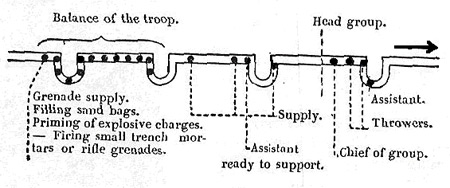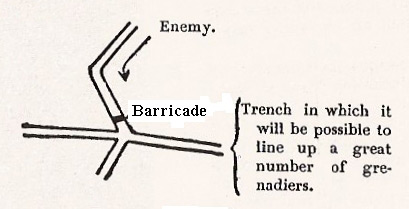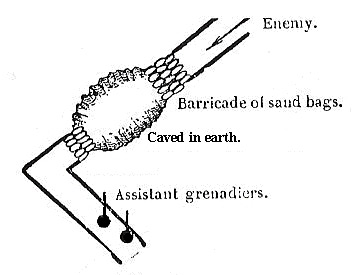Tactical Use of the Hand Grenade (Raiding)
A hand grenade fight can have the following aims:
Defense of a Trench and the "Wearing Down" Struggle
The placement of the grenadiers and grenade depots is to always be incorporated into the "plan of defense" of company and battalion sectors. The grenadiers are divided up into small groups all along the line. Their number is increased on the more exposed fronts (salients, points nearest the enemy, etc.). In such cases, it is advised to double these trench elements by establishing covering positions located close by the first line ones, so as to form in essence two lines of grenadiers at these points. Every soldier, unless clumsy, is expected to execute a barrage at 25 meters, with the allotment of one man to every 10 meters with offensive grenades (O.F. grenade) and one man to every 25 meters with defensive, or "parapet," grenades (F1, F2, CF grenades). (For more information on these, see the Grenades page.)
So as to avoid losses at the points where the trenches are nearest to each other, a marked superiority in the throwing of grenades must be attained in order to make it impossible for the enemy to remain in his trench. Emplacements for grenadiers and grenade depots must be established in the cover trench at the intersection with communication trenches, as well as in the communication trench themselves and in the shelters, which will help in defense if the enemy should take the positions. The various detachments of grenadiers should be well trained in the rapid organization of counter-attacks with grenades to retake any lost part of the positions.
Foot-By-Foot Progression in a Trench
The arrangements in view of a fight in the trenches must above all be made so as to avoid crowding. Only the smallest possible number of men must be exposed to the enemy grenade fire and they must have ample room to move around in order to avoid the former. This small detachment is referred to as the "head group." This mode of fighting is very strenuous. It is therefore necessary to arrange frequent reliefs. In addition, the group commander must be able to immediately replace every man who is disabled and to reinforce the forward head group with fresh riflemen and throwers.
The strictest silence must be observed so as to hear any sound which might indicate the enemy's intentions. Thus, as much as possible, all orders and communcations should be given by signs and signals. The group advances by single file and in the following order: aides, lanceurs, pourvoyeurs (see figure below).

The grenadiers (who must be resupplied uninterruptedly) continuously throw grenades, some on the nearest group of enemy and others as far as possible so as to impede the enemy's supply of grenades and men. When the head group is satisfied that the enemy is overwhelmed (i.e. slackening or stoppage in the enemy's fire, or an indication given by sound), the assistant grenadiers slip into the smoke, quickly look at the turning and beckons to his comrades. In this manner progress is made, from turning to turning and traverse to traverse.
When the assistants come upon the entrance to an adjoining communication trench, he signals the throwers who then lob grenades into this communication trench. After this, the trench is explored in order to prevent a surprise attack. Should the advance not be continued in this communication trench, a barrage ("barricade") of sandbags is established and guarded beyond grenade range from the main trench. A group is specifically assigned to fill sandbags so as to allow the rapid erection of barricades. Rifle grenades or light trench mortars can also be used to impede the enemy's resupply of grenades and men.

When the enemy has managed to become momentarily superior, the ground taken must be defended foot-by-foot until the advantage is regained. In this case, the number of barricades is increased to slow the progress of the enemy. The trench should be obstructed by piles of sandbags and other material at hand or caved in so as to oblige the enemy to expose himself in the open to rifle fire. The enemy should be drawn to a point where it is possible to organize a greater number of grenadiers than he can. Simulating the cries of wounded should be done in order to draw the enemy out and take him by surprise.

Preparation For an Attack On a Trench
An assault is generally a combined action which is executed under the protection of powerful artillery barrages. However, sometimes during the course of an engagement a portion of the troops is positioned very near the enemy and artillery preparation can not occur. In such a case, the enemy must be overwhelmed with grenades and then rushed with the bayonet. Throwers approach the enemy and take advantage of all terrain features for cover. Meanwhile, the rest of the group remains sheltered and waits for the moment of attack. The grenadiers overwhelm the enemy with a continuous hail of well-directed grenades and force him to either flee his positions or get into his shelters. At this moment, the attack is made with all speed and energy.
Fighting and "Cleaning Up" Inside the Enemy's Positions
The assault is followed by a fight inside the enemy's positions. This fight can be previously prepared through prior knowledge of the enemy's defensive organization. Certain groups of grenadiers can thus be assigned specific, well-defined missions such as: progression through the communication trenches toward the cover trenches and second line positions, or "cleaning up" of the trenches and shelters. The groups which are assigned these roles must be previously trained in such exercises.
The cleaning up of positions is carried out by men referred to as nettoyeurs de tranchée ("trench cleaners") and comprises two distinctive parts which must not be executed by the same groups. These are:
- The destruction of groups of enemy which continue to resist at certain points.
- The actual cleaning up, which consists in making sure that no enemy is left in the conquered trenches and shelters.
The trench cleaners are armed primarily with grenades, pistols, knives and trench clubs. The groups which are assigned to break any eventual resistance are mainly, if not exclusively, composed of grenadiers. They advance with the first or second assault wave, continually on the look-out, and immediately rush against any resistance. They run as far as possible along the top of the trench so as to reach the least defended portion. The groups allotted for the cleaning up proper of the positions follow a fixed route. They rapidly skirt the trenches, their progress arranged so that no part of the enemy's positions is forgotten. To avoid any loss of time, this group must not go down into the trenches. They will toss down grenades into the trenches as they pass along the parapets. Particular attention must be paid to the entrances of shelters, which are often obstructed as a result of the bombardment and are not always visible. If prisoners are taken (and often they were not as giving quarter in the middle of on-going fight was difficult and hazardous) are quickly assembled and escorted away by the commanding NCO, or by special groups previously allotted for that purpose.
Carrying Out a Raid
The grenade is heavily relied upon when carrying out coups de main, or "raids." Raids are constituted of either:
In both cases above, it was advisable to utilize men or units who were highly motivated and aggressive. The purpose of a raid was generally to do one or more of the following:
The success of such an operation depends essentially upon the care with which it has been prepared, along with the element of surprise. This means reconnoitering the objective and rehearsal in the rear of all the phases of its execution under conditions as real as possible.
PREPARATION
The preparation must be carried out with scrupulous care. The particular role of the officer who has to lead the raid is:
- To make or have made all the reconnaissances necessary (terrain, auxiliary defenses, enemy trenches, etc.). This terrain must be studied from two points of view: means of approach and means of cover for the grenadiers who must be placed within grenade range of the enemy's positions. The enemy's defensive organization is best studied with aerial photographs.
- To study the conditions under which the raid will be carried out (day, hour, etc.)
- To allot a clearly defined mission to each squad or detachment of grenadiers.
- To seek the best method of grenade resupply and specially appoint a subordinate to oversee this during the raid.
- To well inform the infantry and artillery units which are to support him on the manner in which he intends to carry out his raid.
ATTACK ON THE POSITION
The group which is to carry out the raid silently approaches the enemy trench. If there has been artillery preparation, the approach must be extremely rapid. When the group is near the assigned points for entry or passage over, a volley of grenades is thrown into the enemy's trench or post and, immediately after the explosions, the grenadiers leap down into the trench. Such an operation must generally comprise two groups which, upon arriving in the enemy's position, proceed toward the left and to the right respectively to undertake the cleaning up.
Every precaution must be taken to avoid falling under the fire of the enemy's grenades. A position situated a few meters to the rear of the attacked trench or post may have been prepared by the enemy. During the cleaning up, assistant grenadiers are assigned to keep watch, according to instructions given prior to the departure of the raid. It is advisable, whenever possible, to act on a specially dark night or in very bad weather so as to achieve a greater surprise. In such a case, an arrangement can be made between the troops of the departure line and the raiding party beforehand. Several shots fired under the prearranged circumstances will warn the raiding party that a flare is about to be sent up. The raiding party then lies down and takes advantage of the light to study the lay of the land. As soon as the flare is extinguished, they make their rush and await if necessary another flare.
The supply of grenades must be a primary concern of the commanding officer. The most scrupulous measures must be taken to prevent the grenadiers from running short of ammunition. These precautions must be based upon the fact that out of every two grenades sent up from the rear, only one reaches its destination.





